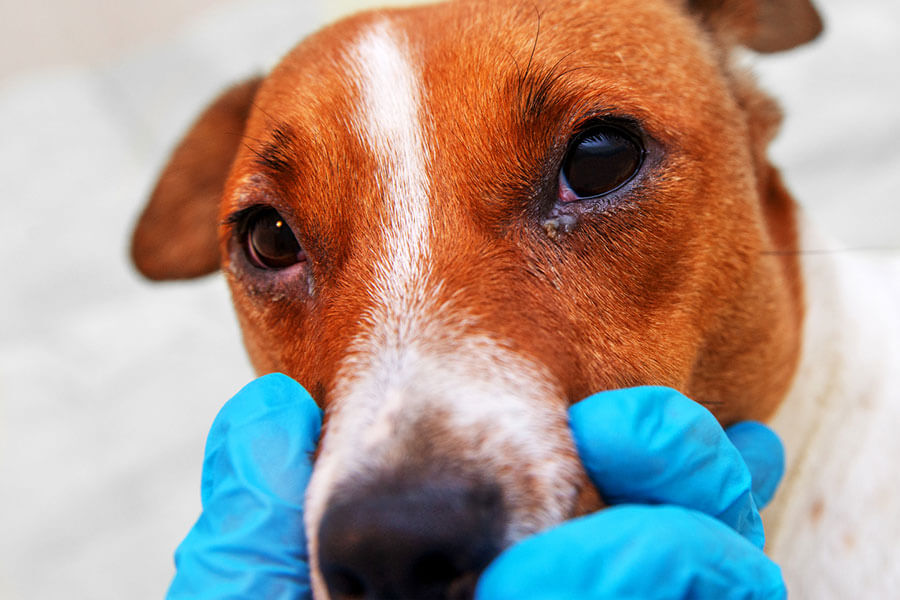Conjunctivitis in Dogs - Symptoms and Treatment
•Posted on January 17 2023
Last updated on December 01 2025

Have you noticed weepy, bloodshot or irritated eyes in your dog? Are they rubbing their face on the ground or blinking a lot? If that’s the case, your pet might suffer from a condition known as dog conjunctivitis.
Similar to a human version, canine conjunctivitis appears suddenly; out of nowhere, it’s unpleasant and requires professional help. If this is your first time dealing with canine conjunctivitis, here is what you need to know.
What is dog conjunctivitis?
Conjunctivitis occurs when the conjunctiva, or the tissue surrounding the canine’s eyelids, becomes irritated.
This is an uncomfortable eye condition that may cause excessive facial pawing, blinking or squinting. Your dog might have a discharge from their eye and swelling. Conjunctivitis also goes by the name pink eye and affects cats, dogs and humans equally.
It can cause discomfort and it’s always best to visit the vet if you think something is wrong with your pet’s eye. Treatment depends on the cause, but the sooner you start treating their eye condition, the less severe symptoms will be.
Types of conjunctivitis in dogs
Allergic conjunctivitis: Any breed can develop allergic conjunctivitis, but it particularly affects dogs predisposed to atopic dermatitis. It usually happens in young adults but can occur at any age. Frequent contributors are food allergens, perfumes, shampoos, mites, moulds, pollen and atopy, which is a genetic tendency to develop allergies.
Viral conjunctivitis: If your dog catches viruses that cause inflammation, they may develop viral conjunctivitis, which affects all breeds. These viruses are contagious and your dog might need up to four weeks to fully recover. Common viruses are canine herpesvirus and distemper virus.
Bacterial conjunctivitis: Primary bacterial conjunctivitis is not ordinary in canines and there is no breed, age or gender predisposition. Usually dogs will catch a secondary bacterial infection due to underlying medical issues.
These conditions include corneal ulceration, eyelid abnormalities and chronic dry eye in dogs. Bacteria that cause conjunctivitis are Staphylococcus and Streptococcus and are very contagious for canines.
Symptoms of conjunctivitis in dogs
The most common symptoms include red, inflamed eyes and discomfort. Depending on the type of infection, your pet may have a discharge and excessive blinking.
Other symptoms include:
- Eye discharge is watery, green, yellow or cloudy
- Swelling around the cornea
- Rubbing at the eyes
- Irritation or mild discomfort
- Redness

What causes dog eye infection?
Many things can cause canine conjunctivitis, ranging from allergies and environmental irritants to viral and bacterial infections. For instance, if your pet has conjunctivitis in only one eye, it might mean they have inflammation due to a possible scratch or dryness. If both eyes are affected, it can indicate a bacterial or viral infection.
- Bacteria: bacterial infection resulting in the pink eye may indicate your pet has some underlying health condition, like Lyme disease. If you notice pink eyes in your dog, take them to the vet immediately.
- Virus: Viruses can cause conjunctivitis in dogs, by triggering inflammation.
- Foreign bodies: Dirt or dust can get stuck in your pet’s eyelids and cause conjunctivitis.
- Inflammation: Inflammation can affect canine’s tear ducts, leading to conjunctivitis.
- Dry eye: This condition is similar to cloudy eyes, creating irritation and inflammation and increasing the likelihood of eye trauma.
- Abnormal eyelids: Eyelid deformities can cause irritation, resulting in pink eye or inflammation.
- Trauma: Trauma to the eye or foreign objects, environmental pollutants or smoke can irritate the eyes and cause inflammatory conjunctivitis.
- Allergies: In most cases, allergies are mainly responsible for eye infections and conjunctivitis in dogs.
Dog conjunctivitis treatment
Treating dog conjunctivitis may depend on several factors. For example, vets treat allergic conjunctivitis with ointment that contains steroids or with eye drops. Antihistamines and oral steroids may be recommended if your dog is dealing with systemic inflammation. Prevention is key to allergic conjunctivitis, so make sure your dog avoids underlying allergens. Your veterinarian might recommend food trials, environmental changes, flea preventatives and skin testing.
Topical antibiotics are used to treat bacterial conjunctivitis. In some cases, anti-inflammatory drugs and oral antibiotics might be administered, depending on the severity of the condition. Your dog might need something to boost their immune system and sometimes anti-viral or oral medicines.
To apply prescribed drops at home, follow these steps:
1. Clean the Eye Area
Before applying any eye drops, ensure your dog’s eyes and the surrounding area are clean. Use a soft, lint-free cloth dampened with warm water to gently wipe away any discharge or debris. Avoid using harsh cleaning agents or soaps as they can irritate your dog’s eyes. Keeping the area clean prevents bacteria or dirt from entering the eye during treatment, helping the medication work more effectively and ensuring your dog’s comfort.
2. Position Your Dog
Securing your dog in a comfortable position is essential to prevent sudden movements during application. Sit or kneel beside your dog, holding them gently but firmly. For smaller dogs, you can place them on a raised surface. If your dog is large or fidgety, having another person assist can make the process easier. A calm and reassuring tone can help reduce your dog’s anxiety, making them more cooperative.
3. Create a Pouch
To apply the eye drops effectively, pull your dog’s lower eyelid downward with your thumb or fingers, creating a small pouch. This pouch ensures the medication is applied directly to the eye without spilling or missing the target. Be gentle to avoid discomfort or stress for your dog. This technique also minimises the chance of accidental injury, as the bottle or applicator will remain at a safe distance from the eye.
4. Apply the Drops
Carefully hold the dropper close to your dog’s eye without touching it to avoid contamination. Administer the prescribed number of drops into the pouch you created. Be precise and quick to minimise stress. If your dog becomes uncooperative, pause and calm them before continuing. Never force the process, as it may cause distress. Once the drops are applied, step back and let your dog blink naturally to distribute the medication evenly.
5. Allow Natural Blinking
After releasing your hold, let your dog blink naturally. Blinking helps spread the medication across the surface of the eye, ensuring it reaches all affected areas. Avoid touching or rubbing your dog’s eyes after administering the drops, as this can cause irritation or remove the medication. Observe your dog for a few moments to ensure the drops stay in place and that they are not immediately rubbed off by pawing or shaking.
6. Spacing Medications
If your veterinarian prescribes more than one type of eye medication, it’s essential to wait at least five minutes between applications – this pause prevents dilution or interference between treatments. Always apply ointments last, as they create a protective layer over the eye. Follow the sequence and timing recommended by your vet to ensure optimal effectiveness. Adhering to this schedule will help speed up recovery and provide relief for your dog.

Canines diagnosed with eyelash or eyelid abnormalities will need surgical intervention to avoid chronic issues. Dogs with chronic dry eye will require continuous medication stimulating tear production. Don’t try to treat your dog alone by using over-the-counter medication. At this point veterinary care is necessary.
Regardless of your dog’s condition, your vet might suggest that your pet wears an Elizabethan collar until the conjunctivitis issue is resolved. Even though this collar might seem a nuisance, it will prevent your dog from making their eyes worse by scratching or rubbing.
Can you prevent conjunctivitis in dogs?
It’s possible to prevent some cases of conjunctivitis. For example, you can protect your dog from airborne irritants like perfumes, smoke and even dust. Keep up to date their vaccinations against diseases that tend to provoke conjunctivitis, like canine distemper and make sure they receive regular veterinary care.
If your pet is infected with conjunctivitis, you need to keep them away and isolated from other animals until they are healthy again. Dogs that are constantly around other animals need to have their paws and faces wiped clean every time they come home. You should wash your hands after touching your dog’s face, toys or bowls. Remember that good hygiene will keep everyone safe.

Is conjunctivitis contagious for other pets and humans?
Allergy or injury-caused conjunctivitis is not contagious. If conjunctivitis results from an infection or a virus, it can be transmitted from one dog to another. Some types of bacterial conjunctivitis can potentially be passed to humans, but it rarely happens.
If you are dealing with an infected dog, it’s really important to wash your hands to prevent the spread of the infection. Don’t touch your face when near the infected dog. If you notice any signs of infection, contact your doctor immediately.
How long does conjunctivitis in dogs last?
It depends on an underlying cause. Bacterial conjunctivitis can be fully resolved within seven days with appropriate treatment, while viral conjunctivitis needs at least three weeks of treatment. Allergic conjunctivitis is preset until the underlying allergen is eliminated and during the treatment the veterinary care is necessary.
The most common dog vision problems
Cataracts in dogs
The cloudy appearance of a dog’s eyes is one of the first signs of cataracts in dogs. Early diagnosis is crucial since surgery might be able to preserve your pet’s eyesight.
Glaucoma
Glaucoma is a painful condition that can be treated. Symptoms include green or yellow discharge from their eye, bloodshot eyes, dilated pupils, or delayed reaction to blind light. If you leave glaucoma untreated, your dog may end up partially or completely blind. But the vet can perform a minimally invasive glaucoma surgery that will relieve intraocular pressure.
Progressive Retinal Atrophy
Progressive Retinal Atrophy can be challenging to detect due to its slow progression. While painless, this condition causes the deterioration of the retina, leading to blindness.
What is the best supplement for dog eye health?
The best dog eye health supplements improve eye health and vision, protect eye tissue and focus on retinal care. Some active ingredients you should be looking for are vitamin C, EPA+DHA, vitamin E, grape seed extract, alpha lipoic acid, rosmarinic acid, astaxanthin and green tea leaf extract, among others.
Astaxanthin is one of the most powerful antioxidants, which can minimise dry eye symptoms, boost tear production and lower ocular inflammation. Vitamin C is one of the best vitamins for dog eye health, which protects the lens from UV oxidative damage. EPA+DHA are omega fatty acids that contain anti-inflammatory properties and are crucial for retinal health.
The benefits of dog eye supplements
- Improve vision and eye health: Omega fatty acids and antioxidants are common ingredients in eye supplements that boost vision and support different eye structures.
- Increases retinal responses: Lutein is an antioxidant commonly used in eye supplements which improves retinal responses. Canines with poor eyesight tend to have slowed retinal responses.
- Eliminates free radicals: Vitamin E and vitamin C are known for neutralising free radicals and improving eye health. They also benefit the canine’s immune system.

Best foods for dog eye health
A diet rich in antioxidants is highly beneficial for a dog’s eyesight. Unless instructed otherwise, your dog can eat these ingredients raw. To ensure good digestion, puree fruits and veggies.
- Blueberries: Flavonoids, phytonutrients and carotenoids
- Carrots: Vitamin A and beta-carotene
- Kale: Zeaxanthin antioxidants and Lutein
- Broccoli: Beta-carotene
- Sweet Potatoes: Anthocyanins and Beta-carotene
- Salmon: DHA, before swerving, deep-freeze raw salmon
If for some reason your dog refuses to eat these fruits and vegetables; you need to provide proper supplementation to ensure good eye health.
Conjunctivitis in dogs is a common condition in dogs. Even though it’s not life-threatening, we suggest seeking vet treatment immediately. For good ocular health, start giving your pet dog eye supplements.


